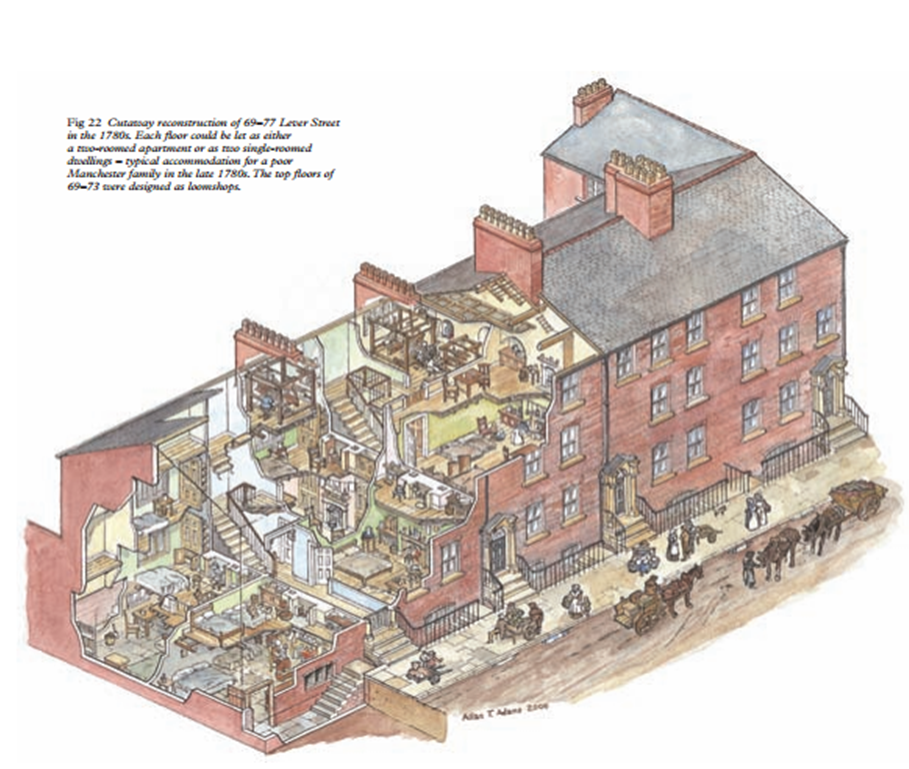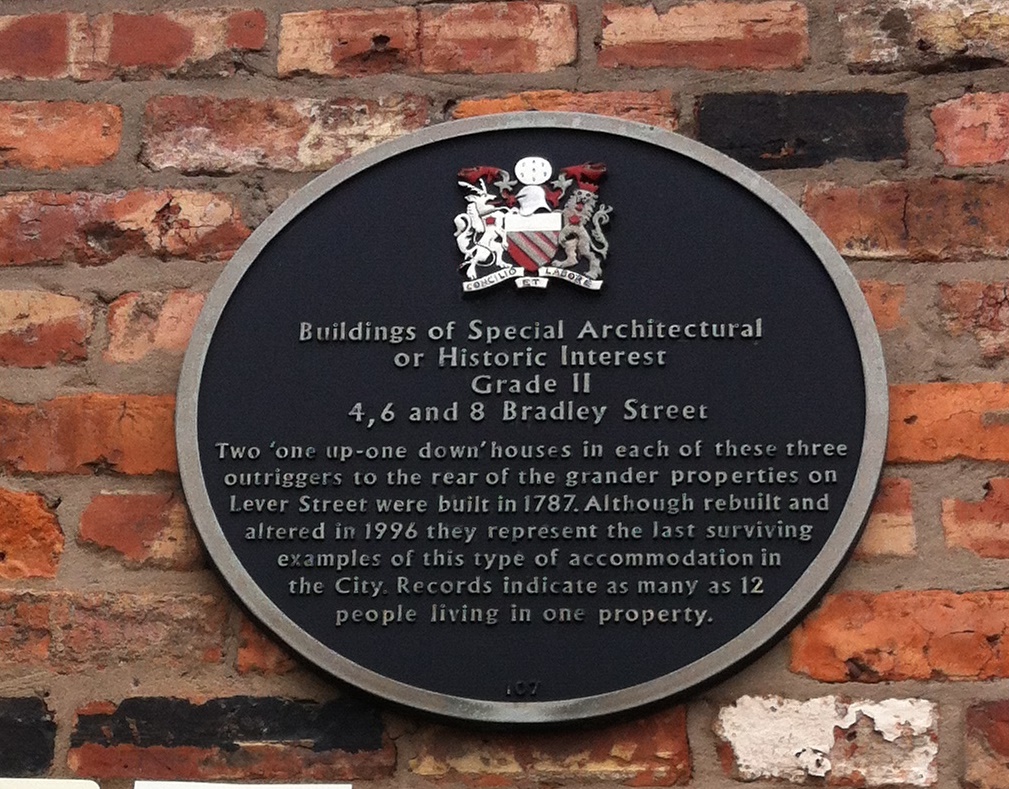The final part of Manchester’s forgotten Georgian heritage again focuses on a former domestic properties. Unlike the other two posts about 67-71 Princess Street and 35 King Street, the three properties at 4, 6 and 8 Bradley Street were built for the working classes and were effectively overcrowded slum housing. It is a miracle these three little buildings have even survived into the twenty-first century.

69 – 77 Lever Street
When conducting my research into the history of Bradley Street, I found I had to begin on the street that runs parallel with it, Lever Street. Following the expansion of the city in the eighteenth century into fashionable ‘zones’, Sir Ashton Lever of Alkrington Hall, near Rochdale began to sell his land to developers in the area now known as ‘Northern Quarter’ and which borders Ancoats. This part of Manchester had already been partly developed by William Stevenson, but Stevenson’s plans for middle-class housing were not so popular and many houses remained vacant, even the church-fronted Stevenson Square.

In 1787, a well-to-do plasterer Mr. Bradley (his first name seems to be disputed, I’ve seen it recorded as both Charles and William) built the elegant fronted Numbers 69-77 Lever Street. Unfortunately as this area was still unfashionable with Manchester’s wealthier residents, only one of the townhouses was inhabited by a single household. The rest of the properties were designed as tenement homes, some of them had loom workshops on the top floors. However, unlike other domestic weavers workshops in the Northern Quarter, the long ‘weavers windows’ were restricted to the rear of the properties and the to preserve the elegant facade of Lever Street.

Soon after the construction of the properties, two-storey additions were added to the rear of the properties, as the demand for cheaper housing rose in the booming town centre. Within a few years further additions were added onto these extensions, three small single storey ‘cottages’, some with cellars, opening onto Bradley Street. The street was named after Mr Bradley. The three cottages facing Bradley Street and the three extensions which connected them to the back of the houses on Lever Street were all occupied as houses. To access the houses at the back of the cottages on Bradley Street, you would have to pass through a common shared yard. The gateways were still visible in the black and white photo at the top of this post. Therefore, there were six very small residences all jumbled on top of each other, sharing walls and built without proper ventilation or sanitation.
Numbers 4, 6, 8 Bradley Street
These three cottages on Bradley Street were originally inhabited by skilled artisans and were actually slightly larger than other similar properties at the time. However, with the birth of the industrial revolution, these highly-skilled occupations were swept away by machinery and Bradley Street became home to some of Manchester’s poorest working class people.
What was life in Manchester like in the late 18th and early 19th century for our residents of Bradley Street? In 1802 the poet Robert Southey visited Manchester and this was his judgment:
“Imagine this multitude crowded together in narrow streets, the houses all built of brick and blackened with smoke; frequent large buildings among them where you hear from within the everlasting din of machinery and where when the bells rings it is to call the wretches to their work instead of to their prayers. Imagine this and you have the materials of a picture of Manchester.”

Even into the nineteenth century, the cheap housing on Bradley Street, offering a domestic residence within close proximity of place of work still appealed to Manchester’s residents. The 1851 census revealed just how over-crowded the houses were.
For each property there were two entries recorded for each address. This was because the two cottages backed onto each other. Each property only contained two rooms; the ground floor room which would be used as a kitchen and communal living area and an upstairs room as a bedroom. In one property at Number 4 Bradley Street was 50 year old widow Ann Mortimer and her children; Richard, aged 22, Jane aged 20 and Maria, aged 18. The Mortimer family were Irish and they had lived in Manchester since at least 1841. Richard Mortimer was a labourer and his sisters worked in cotton mills. Despite their already crowded home, the Mortimers had a lodge, Edward Bawer, who also lived in the hosuehold and would have supplemented the family income. The 1861 census reveals that the Mortimer family were still living at Number 4 Bradley Street.
In the other property at Number 4 was Matthew Hodgson and his wife Mary and their young children Martha, David and James. Matthew’s occupation was listed as a boatsman, probably on Manchester’s vast canal and river network.
At Number 6 was George Burrows, a hawker, his wife Sarah and their children; Thomas, Mary Ann, Eliza and George. At the other property at Number 6 was Samuel Goodwin, who at 68 years old had exceeded the average life expectancy for someone of his class. As the Old Aged Pension Act was not introduced until 1908, Samuel still had to work as a bookkeeper on the canals in order to pay his rent and feed his family. Also living in the property was his wife Martha, his step-daughter Jane and on the night of the census there was a visitor, Emma Eliza Brook.
James and Mary Wheatley lived at Number 8 along with Elizabeth and James Nuttall, Mary’s children from her previous marriage. James and Mary had a daughter together, 6 year old Margaret. Mary Blacklead, Mary’s sister was also living with the family. Both James and Elizabeth were steam loom weavers.
Living at the other property at Number 8 was Richard Thomas, a joiner and his wife Elizabeth. Like some of other households they had a lodger, 19 year old Anna Jacques, who it appears was working as a waitress.

All three properties were still occupied in 1877 but by 1881 only Number 8 was still being used as a domestic residence, despite being built almost a hundred years earlier. It was home to the Pennock family, who had lived there since 1877. Frederick G. Pennock (1855-1913) was a labourer in a lead works. He had married Mary Ann Swarsbrick in 1873, she was 16 years old at the time and he was only 18 himself. By the time of the 1881 census Frederick and Mary Ann had two children; Sarah, aged 5 and John, aged 3. Despite this, the impoverished circumstances of the family meant Mary Ann also had to work and she was a cotton winder in a mill. Fortunately, the Pennocks left Bradley Street soon after the census and they went on to have three more children: Frederick, Mary and Charles.
Two of the houses were still occupied as domestic residences as late as 1895. William Shaw lived in Number 6 and James Pinkerton lived in Number 8 (he had been there for 13 years by that point). Both men paid 3 shilling a week in rent. By 1900 the buildings were being used as offices.
Bradley Street Today
It is remarkable that these buildings survived the clearances of the 20th century, considering they were never intended to be lasting architectural creations. They were given a Grade II listed status relatively late in 1984 and at the time of listing they were in a poor condition and a state of disrepair.
Fortunately in 1987 Manchester City Council expanded the zones on their Stevenson Square Conservation area to include Bradley Street and also the houses on Lever Street. In 1996 the buildings were stripped apart for conservation and partly reconstructed so that they could be utilised once more.
These are extremely rare listed buildings on a national scale. For over 220 years they have stood the tests of time and they stand proudly as a silent tribute to the ordinary, working-class people of the eighteenth and nineteenth centuries, who powered the industrial revolution and shaped the world we know today.

Researched and Written by Thomas McGrath
~
Enjoy what you’ve read? Each article is the result of hours of research and writing. If you like, please consider supporting this blog by ‘buying me a coffee’ over on Ko-Fi! https://ko-fi.com/thomasmcgrath
~
Sources:
- Census Records – http://www.ancestry.co.uk
- Old Photographs & Information about listed buildings – http://www.britishlistedbuildings.co.uk
- http://www.manchester.gov.uk/info/511/conservation_areas/1208/stevenson_square_conservation_area/4
- Robert Southey’s Quote – ‘Portrait of Manchester’ by Michael Kennedy (London: Robert Hale & Co.,1970) p.50
- ‘Manchester’s Northern Quarter: The Greatest Meer Village’ by Simon Taylor and Julian Holder (with Manchester City Council and English Heritage) (Swindon: English Heritage, 2008) pp. 23-27

My ancestor Bridget Cunningham was living at 29 Bradley Street when she got married in 1853. Can I assume that no.29 was a similar dwelling to numbers 4,6 and 8? In 1851 she was lodging in Charlotte Street with 14 other people.
LikeLiked by 1 person
Hi Ian,
Thank you for commenting. Looking at an old map of Bradley Street from the 1850s the rest of the street appears to be similar housing as numbers 4,6&8. Number 29 would have been build later than these properties but it still would have been small, overcrowded conditions, back-to-back with other larger properties and businesses fronting on Lever and Spear Streets. Charlotte Street would have been a better Street to live on visually; as it was wider and there were important buildings located there such as the Portico Library and St. James’s Church, however as you’ve mentioned it was just as overcrowded!
Thanks,
Tom
LikeLike